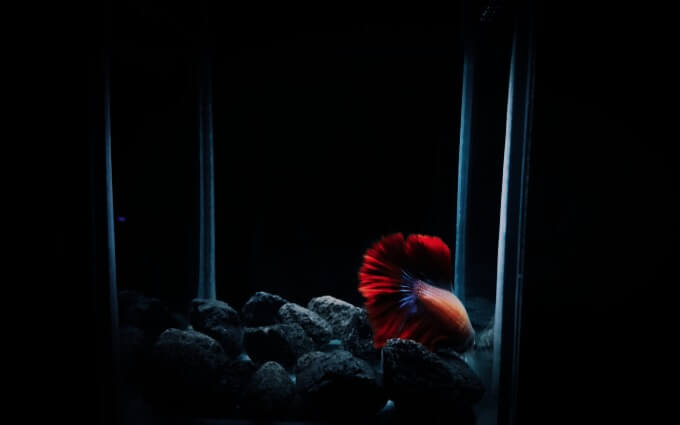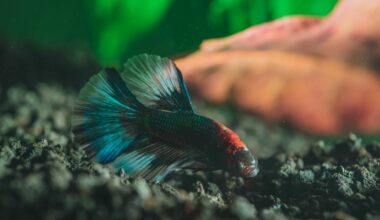Many owners go into a panic when they see a Betta fish laying at the bottom of the tank. They assume something is seriously wrong.
After all, fish are supposed to swim right?
But actually, it’s a bit more complicated than that. There are a number of potential reasons why a Betta might be laying at the bottom (and not all are bad).
And this guide is here to help.
It will teach you why they might be at the bottom of the tank, how you can address each issue, and how to use positional and behavioral signs to accurately diagnose any problems.
Table of Contents
Is It Normal For Betta Fish To Lay On The Bottom Of The Tank?
Betta fish are some of the most beautiful around. With their long flowing fins and vibrant coloration, they are at their best when swimming around your aquarium and displaying their beauty.
But what does it mean when a Betta starts laying at the bottom of your tank? Is it normal?
Witnessing this behavior can be alarming for owners who are used to seeing their fish acting feisty and playful.

There are actually several reasons why a Betta might do this, and some of them are innocent enough. However, others are cause for concern.
This means it’s normal, sometimes.
All Possible Causes
Understanding your Betta fish’s behavior could help you determine when you need to take action. Here are some of the most common reasons why a Betta fish is laying at the bottom of the tank.
1. The Betta is Getting Older
Bettas have a relatively short lifespan. In good conditions, these fish will live between three and five years! If you’ve had your Betta for a while, they could be suffering from the effects of old age.
Like any other animal, old Bettas tend to slow down as they get older. They simply don’t have the energy to zip around their habitat like they did when they were younger. Their bodies start slowing down and they have a harder time keeping up with younger fish.
As a result, most older fish prefer to rest a bit more. Your fish could start laying down on leaves or spending more time resting on the substrate at the bottom of the tank.
Author Note: Unless you raised your fish from the fry stage, it’s difficult to determine the age of fish. Even if you just got your Betta a few months ago, they could have spent years with a breeder or at the store. If your fish looks generally healthy and just seems to be slowing down, they may be reaching the end of their life.
2. Ammonia Poisoning
As your fish produces waste, ammonia levels in the tank are going to rise. As you probably know, ammonia is a dangerous chemical for fish. It can cause chemical burns in the gills and eventually lead to death.
The problem with ammonia is that you can’t see it. You have to rely on good tank maintenance and monitoring to prevent these levels from skyrocketing. In other words, regular water changes and a good filtration system.
If you don’t have an effective filter in place, ammonia levels will constantly climb. This weakens your Betta fish.
Basically, they’re struggling to breathe!
Small tanks or environments that are overcrowded tend to suffer from ammonia problems as well. Use a testing kit to check ammonia levels. The only “safe” level is 0 PPM. Anything higher and your fish could be suffering.
3. Excessive Current
Betta fish do not fare well in strong currents. In fact, their massive fans are purely ornamental. They don’t do much to help this fish swim.
If you have significant flow coming from the filter or and air pump, your fish might be probably exhausted!

It takes a lot of energy to constantly fight a strong current. Your Betta fish might have given up and decided to rest by laying at the bottom of the tank.
To reduce water flow from your filter, you can attach a sponge filter. Alternatively, you can redirect the current towards plants or decorations. Breaking up the current will do a lot to reduce flow throughout the aquarium.
4. Nitrate Poisoning
Nitrate is another compound created by fish waste. However, it’s a byproduct of bacterial breakdown. Bacteria in a well-cycled tank will convert ammonia to nitrites. Then, it’ll break the nitrites down to nitrates.
Comparatively speaking, nitrates are less harmful than ammonia. However, they still do a lot of damage.
And to make matters worse, nitrate is a slow killer.
It makes fish lethargic and weak (and might cause them to lay at the bottom of the tank). Your Betta could lose its appetite and have difficulty breathing. You might even see their color start to wane.
Whip out your water test kit and see where the nitrate levels are. Ideally, you shouldn’t have more than 5 to 10 PPM.
5. The Water is Too Hot
Temperature shock is a very real threat to Bettas. These fish do enjoy warmer temperatures. However, excess heat during the summer will pose several health problems.
You see, warm waters release oxygen much quicker than cool waters. It’s not so much the temperature that’s the problem. Rather, it’s the lack of oxygen that’s affecting your fish!
Without that oxygen, your Betta fish will be gasping for air at the bottom of the tank. Even with their ability to breathe atmospheric air, water without a good supply of oxygen is a serious problem.
Author Note: Cool down the temperatures of your tank slowly. You can do this with a fan or room air conditioner. To infuse some oxygen in the water quickly, use an air bladder.
6. Swim Bladder Disease
Your fish’s swim bladder is a crucial organ that it needs to swim. It controls buoyancy. When a fish suffers from swim bladder disease, they often swim in strange patterns, have difficulty moving, or lay at the bottom of the tank.
This disease is pretty common with Bettas. These fish have healthy appetites and as a result, they often eat more than they should. This causes can cause constipation and swim bladder issues.
You can treat the disease by providing high-fiber foods like Daphnia and blanched peas. To avoid it in the future, reduce the amount of food you’re providing.
Sometimes, swim bladder disease is chronic. Treatment doesn’t help all fish. In those cases, fish usually have to be euthanized.
7. Sickness & Disease
If your Betta fish is looking lethargic and spending time laying at the bottom of the tank, they could be sick.
There are many diseases that affect Bettas. In fact, these fish tend to experience disease more often due to a weaker immune system.
Diseases like Ich, Bloat, Dropsy, and more can cause Betta fish to get weak.
Author Note: In most cases, these diseases are caused by stress and a poorly maintained environment. Stay on top of water conditions and make sure that parameters are within an acceptable range.
When things go beyond the recommended range, your Betta fish will grow stressed and become more susceptible to disease.
8. Just Taking it Easy
A Betta fish laying at the bottom of the tank isn’t always a cause for concern. Sometimes, your fish is just taking things easy!
Take a look at their behavior. If the pelvic fins are still in motion, your fish might just be relaxing! They may go through bouts of movement before resting on the substrate.
While those enormous fins look great, they can be tiresome for a Betta. Because of this, they might take a moment to rest. This is completely normal and nothing to panic about!
9. The Water is Too Cold
Like excess heat, cold waters beyond the Betta’s comfort range can cause trouble. Ideally, the water temperature of your tank should be no lower than 74 degrees Fahrenheit (learn more by reading our complete care guide).
When the temperature drops below that, your fish’s metabolism will slow down. Oxygen absorbs slower, too. This combination of events causes your fish to get very weak and lethargic.
If you don’t raise temperatures, your fish could become stressed and come down with a disease.
Author Note: Use an in-tank heater or lights to slowly raise the water temperature in the aquarium. Don’t try to do it all at once!
10. The Aquarium is Not Large Enough
Many new fish owners make the mistake of thinking that Bettas can live anywhere. It’s true that they do fine in aquariums that hold as little as three gallons.
But bigger is always better!
When your fish is confined to a tiny barren environment, they don’t have anything to do! There’s nothing to explore. Your Betta fish will lose interest in things quickly, leaving nothing for them to do but lay at the bottom of the tank.
That’s not exactly the best way to live, is it?
Give your Betta fish some extra room to explore. Consider bumping the tank size up a few gallons. You should also implement all kinds of enrichment items for your fish.
This includes caves, plants, and natural decorations. All of these things will keep your fish happy and healthy.
11. They’re Sleeping
Believe it or not, Betta fish sleep just like any other animal! They actually follow the same general sleep rhythm as humans. They like to rest at night and stay active during the day.
If they don’t get enough sleep at night, you might find them snoozing at the bottom of the tank!

Bettas have a unique reputation for finding interesting spots to sleep. They can cuddle up in nooks, rest on the substrate, or even sleep on top of plant leaves!
If you notice your Betta sleeping a lot throughout the day, think about your nighttime setup. Do you leave the tank lights on at night? How about ambient lighting in the room?
Leave your fish in a dark quiet space at night to ensure that they’re getting all the sleep they need.
The Importance Of Positioning
The way your Betta fish lays on the bottom of the tank is important to note. Different positions and movement patterns can actually help you pick the correct cause from the list above!
Below, we go into some of the most common signs to look out for.
What Causes A Betta Fish To Lay On Its Side?
In most cases, a Betta fish laying on its side is not a major concern. Bettas actually like to sleep on their side rather than an upright position.
Author Note: Take a close look at their gills to make sure that they’re breathing and otherwise healthy. A healthy Betta should perk right up once they awaken.
Even though side-sleeping is perfectly normal, you can give your fish more options if you want to keep them off the substrate.
Consider adding plants to the aquarium. There are also many “sleep shelves” and artificial caves available. These decorative items are specifically made for sleeping fish!
What If Your Betta Is At The Bottom Of The Tank Not Moving?
If your fish isn’t moving, you need to take a closer look to see what’s going on.
Take a look at their gills. Hopefully, your fish is breathing alright! If so, they’re probably just sleeping. Bettas can’t close their eyes, so it’ll look like they’re still awake.
If your fish is attempting to move its fins, you might be dealing with temperature shock or swim bladder disease. Adjust the temperature accordingly, but make sure to do it slowly.
Unfortunately, there’s not much that you can do to provide immediate relief for swim bladder disease. You can reduce water flow to make things easier on your fish. However, it’s largely a waiting game until you can provide high-fiber foods.
Lastly, there is the possibility that your Betta fish could be dead. Chances are, you’ll see the signs of death coming before this happens. Because Bettas can’t close their eyes, it’s easy to mistake death for sleeping.
If your fish isn’t moving its gills, there’s a good chance that they’ve already passed on.
What Causes Them To Lay At The Bottom Of The Tank Upside Down?
Seeing your Betta fish in an upside-down position is a major red flag! Typically, it’s a sign that your fish has swim bladder disease.
If they’re still breathing or attempting to move their fins, you can easily tell that there’s still something going on internally. That’s a good thing.
Reduce the flow in the aquarium and wait things out a bit. You can add some salt to the tank too (that can sometimes help with constipation issues).
What If They’re At The Bottom Of The Tank Breathing Heavily?
If your Betta fish is laying at the bottom of the tank and is breathing heavily, you need to take action as quickly as possible.
There are a couple of potential causes for this:
It could be ammonia poisoning, nitrate poisoning, or hot temperatures. All of these issues make it difficult for Betta fish to breathe, which explains the heavy and labored breathing.
Test the water to see which problem you need to address. If it’s ammonia or nitrate poisoning, perform a 50-percent water change to provide immediate relief. Then, make changes to prevent levels from spiking again.
For hot temperatures, turn on an air conditioner in the room and point a fan towards the surface of the water. Do not use ice cubes or cold water to lower temperatures. You need to do this slowly so that you don’t kill off beneficial bacteria.
Wrapping Up
As you can see, it’s not always a bad thing when you see a Betta fish laying at the bottom of the tank. Sometimes they just need a rest!
But you still need to be prepared if the cause happens to be serious.
Preparation and a consistent level of high-quality care are two things that great owners practice. You need to understand your fish in case you need to help them!
Because this is such a common concern among Betta owners, please share this guide as much as you can. Our hope is to help as many aquarists become informed as possible!

